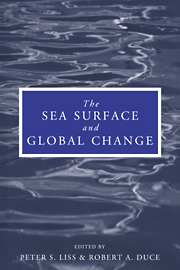Book contents
- Frontmatter
- Contents
- List of contributors
- Preface
- 1 Report Group 1 – Physical processes in the microlayer and the air–sea exchange of trace gases
- 2 Report Group 2 – Biological effects of chemical and radiative change in the sea surface
- 3 Report Group 3 – Photochemistry in the sea-surface microlayer
- 4 Transport processes in the sea-surface microlayer
- 5 The role of organic films in air–sea gas exchange
- 6 Bubbles and their role in gas exchange
- 7 The physical chemistry of air–sea gas exchange
- 8 The sea-surface microlayer and its effect on global air–sea gas transfer
- 9 Chemistry of the sea-surface microlayer
- 10 Biophysics of the surface film of aquatic ecosystems
- 11 Biological effects of chemicals in the sea-surface microlayer
- 12 Neuston of seas and oceans
- 13 Photochemistry in the sea-surface microlayer
- 14 Hydrocarbon breakdown in the sea-surface microlayer
- 15 Applications of laser technology and laser spectroscopy in studies of the ocean microlayer
- 16 Remote sensing of the sea-surface microlayer
- Index
16 - Remote sensing of the sea-surface microlayer
Published online by Cambridge University Press: 24 September 2009
- Frontmatter
- Contents
- List of contributors
- Preface
- 1 Report Group 1 – Physical processes in the microlayer and the air–sea exchange of trace gases
- 2 Report Group 2 – Biological effects of chemical and radiative change in the sea surface
- 3 Report Group 3 – Photochemistry in the sea-surface microlayer
- 4 Transport processes in the sea-surface microlayer
- 5 The role of organic films in air–sea gas exchange
- 6 Bubbles and their role in gas exchange
- 7 The physical chemistry of air–sea gas exchange
- 8 The sea-surface microlayer and its effect on global air–sea gas transfer
- 9 Chemistry of the sea-surface microlayer
- 10 Biophysics of the surface film of aquatic ecosystems
- 11 Biological effects of chemicals in the sea-surface microlayer
- 12 Neuston of seas and oceans
- 13 Photochemistry in the sea-surface microlayer
- 14 Hydrocarbon breakdown in the sea-surface microlayer
- 15 Applications of laser technology and laser spectroscopy in studies of the ocean microlayer
- 16 Remote sensing of the sea-surface microlayer
- Index
Summary
Abstract
Remote sensing methods, primarily from satellites, can contribute to the study of the sea-surface microlayer in several ways. An overview is given of the ocean parameters which remote sensing techniques can measure, and the spatial and temporal sampling capabilities of sensors which are useful for microlayer studies are described and explained. Infrared sensors measure the temperature of the sea-surface thermal skin, but to define the difference between radiometric and in-water measurements of temperature requires an understanding of the physical processes which control the thermal structure of the surface microlayer. The skin temperature deviation has an effect on the interpretation of global datasets of sea-surface temperature. Satellite images are also able to identify circumstances where local meteorological conditions introduce heterogeneity into the surface microlayer temperature. Imaging radars are very effective in measuring sea-surface roughness and detecting its spatial variability. The effects, on the radar backscatter cross section, of surface wind fields, waves, swell, slicks and other dynamical features enable radars to image a variety of physical processes which affect the surface microlayer. By combining data from more than one remote sensing technique it is proposed that air–sea fluxes may be estimated, and also that surface microlayer processes can be related to the wider spatial context of mesoscale variability.
Information
- Type
- Chapter
- Information
- The Sea Surface and Global Change , pp. 471 - 508Publisher: Cambridge University PressPrint publication year: 1997
